Last updated on March 1, 2013
Update 22:30(UTC)/23:30(CET)/07:30/(JST)
I end todays updates with some heartbreaking pictures from the tsunami disaster. Its very hard to even just watch these pictures, I hope the resilience of the great japanese people will astonish the world when they rebuild after this disaster.
Update 21:20(UTC)/22:20(CET)/06:20(JST)
Some Austrian researchers have analysed data from detectors used to verify the comprehensive test ban treaty and their analysis show that the emissions of iodine and cesium from Fukushima is approaching the same level as from the Chernobyl accident. Fukushima emitted around 1,3*10^17 Bq iodine per day the first days and the total emission from Chernobyl was 1,7*10^18 Bq. By now the iodine emissions must be much lower due to the short half life of iodine and they haven’t reported any containment venting for about a week if my memory serves me right. The core inventory of I-131 is now reduced by more than half due to decay(half life 8.02 days) and the other iodine isotopes have even shorter half life. It will be interesting to see more data on this.
It’s good that the evacuation from the area around the reactor was brisk and that iodine pills have been supplied. So far the ground fallout data from MEXI doesn’t look very bad but it might be due to the direction of the wind as stated in the article.
Update 19:15(UTC)/20:15(CET)/04:15(JST)
It is in the middle of night in Japan right now and the news flow is always a bit slower then for obvious reasons. But NISA has still released a new update (values from 18:05 which makes it older than the JAIF updated I wrote about in the last blog update. They have released a PDF with pictures from the control rooms and plant area, here is a direct link to it. They are ne day old and that is why the control room for reactor 1 is dark(they restored power to it today).
17 workers in total has exceeded a total dose of 100 mSv.
Uppdate 16:00(UTC) / 17:00(CET) / 01:00(JST)
New JAIF and NISA(link 1, link 2, link 3) updates. NISa has added a new file to its update that gives more data, among them the dose rates within the containments. The NISA uppdate is from 11:00 and the JAIF update from 22:00 JST. JAIF numbers first followed by NISA within ().
Reactor 1:
Water level in the core: 1.7 meters(1.7m) below the top of fuel assemblies
Core pressure: 523 kPa (532 kPa)
Containment pressure: 390 kPa (400 kPa)
Core temperature(feedwater nozzle): 175 Celsius
Dose rate within containment: 43.5 Sv/hour
Reactor 2:
Water level in the core: 1.15 meters(1.15m) below the top of fuel assemblies
Core pressure: unknown
Containment pressure: 110 kPa (110 kPa)
Core temperature(feedwater nozzle): 100 Celsius
Dose rate within containment: 48.4 Sv/hour
Reactor 3.
Water level in the core: 2.3 m (2.3 m) below the top of fuel assemblies.
Core pressure: 137 kPa (137 kPa)
Containment pressure: unknown
Core temperature(bottom head): 185.,5 Celsius
Dose rate within containment: 55.9 Sv/hour
The pressure in number 1 went up a bit and then started going down. Temperature has been lowered about 70 degrees Celsius. Dose rate by main gate seems to be on a slow decline. Iodine levels in Tokyo water has gone down below the infant limit of 100 Bq/liter. Testing of pumps are ongoing in reactor number 3. More and more vegetables with levels far exceeding the limits for cesium and iodine is found.
Uppdate 9:00(UTC) / 10:00(CET) / 18:00(JST)
During night(swedish) JAIF(link 1, link 2) and NISA(link 1, link 2) has released new updates. The NISA updates(the schematics of the reactors attached at the end of the post) is by the time of writing 13 hours old and the JAIF update 2 hours old. I will write the JAIF numbers below first and the NISA numbers within parenthesis so one can se the change over the last 11 hours.
Reactor 1.
Water level in the core: 1,7 meters(1,7m) below the top of fuel assemblies
Core pressure: 510 kPa (511 kPa)
Containment pressure: 385 kPa (385 kPa)
Core temperature(feedwater nozzle): 243 Celsius
The situation has been stable for the last 11 hours. Containment pressure and core pressure is up about 20 kPa since yesterdays update. The containment pressure is a bit to high for comfort I would say. All though the highest it has reached during the entire accident was about 800 kPa in one of the reactors so it can plausibly handle even a doubling in an emergency, but if it doesn’t go down soon I am afraid TEPCO are going to have to vent the containment. Venting now could be problematic since the steam will contain quite a lot of activity and it could hamper work for hours due to radiation levels. On a positive note, the lights are now on in the number 1 control room showing that there is some progress in restoring electricity. Lets hope the pace will accelerate soon and that the coolant pumps are functional or at least easy to replace!
Reactor 2.
Water level in the core: 1,2m (1,2m) below the top of the fuel assemblies
Core pressure: Unknown(the readings claim below atmospheric pressure so the gauge is most likely broken)
Containment pressure: 105 kPa (105 kPa)
Core temperature(feedwater nozzle): 102 Celsius
Compared to yesterday pretty much nothing has changed. The core temperature and both core pressure and containment pressure remains low. Nothing new about the radiation levels in the turbine building(reported to be around 500 mSv/hour yesterday) that prevents access for repairing equipment.
Reactor 3.
Water level in the core: 2,3 m (2,3 m) below the top of fuel assemblies.
Core pressure: (142 kPa)
Containment pressure: unknown(JAIF states “downscale”)
Core temperature(feedwater nozzle): 80,7 Celsius
The JAIF update has changed the status of the containment from “might be not damaged” to “not damaged”, that is very good news indeed! It means the only damaged containment is on reactor 2 that appears to be quite stable and cool. Sometime during yesterday they seem to have been able to hook up a pump to one of the pipes leading to the spent fuel pool and they can now provide seawater through the cooling and purification line. Hopefully that means there is no need anymore for blind spraying of the number 3 building. Yesterday they managed to restore lights to the control room, but no news about instrumentation or the filtration system to bring down radiation levels inside the control room.
Reactor 4.
The concreter pump truck continues to deliver water to the spent fuel pool at a rate of 50 000 liters per hour.
General remarks:
We have been hoping for the electricity to be restored to the pumps etc since Saturday now. There is no explanation on what problems they have encountered or the status of the pumps. In the Fukushima Daini plant they had to replace pumps after the quake and tsunami so perhaps pumps needs to be replaced at Daiichi as well. The situation appears stable at the moment, but seawater cooling can not continue forever. At some point the salt depositions in the core will start to cause real problems but I do not know what time span we are talking about. If one estimates the salt deposition from the amount of water that could have been evaporated by the decay heat so far one ends up with several tens of cubic meters of salt. It’s hard to know where all of this salt has been deposited though since we don’t know the flow path of the water. On the bright side it seems like the workers are able to access more of the reactor building now as indicated by the fact that they have switched the path of seawater injection for the number 3 spent fuel pool and the number 1 reactor.
Three workers have been exposed to close to 200 mSv. It’s encouraging that they manage to keep the worker doses below 200 mSv so far. If TEPCO is being honest then its unlikely we will see any acute radiation sickness in workers.
Iodine levels in water and vegetables in prefectures close to Fukushima continues to be high.
We’ll try to keep it in english from now on…
Update 07:30 (UTC) / 16:30 (JST)
JAIF just released their 16:00 update. One bit of happy news there is that they now write that the number 3 containment vessel is “Not damaged”.
Screenshot of the update will follow soon when the guy that has access to saving PDF to JPG gets to his computer. 🙂
Radiation levels in the Tokyo water also seem to be dropping again… but it’s too soon to speak of any general trends. Also no new word on Caesium-137 in farmlands or water.
The work to bring electricity to Fukushima I continues (slowly).
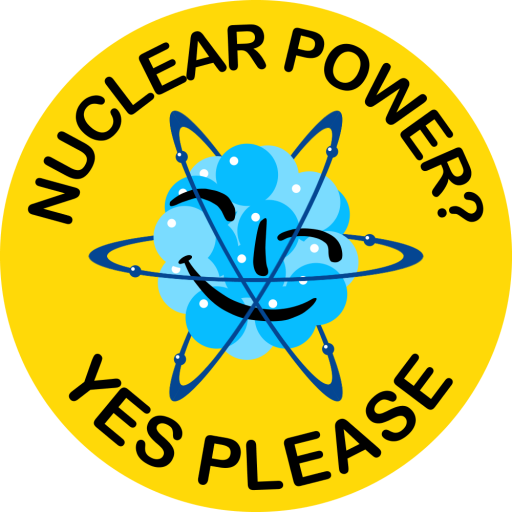
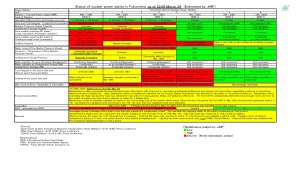

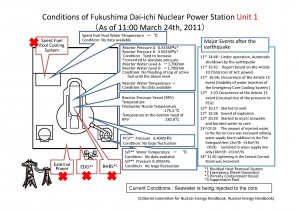
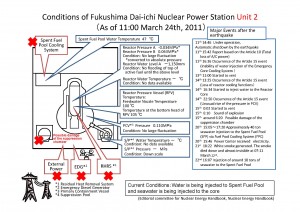

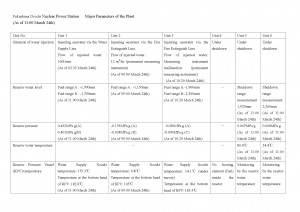

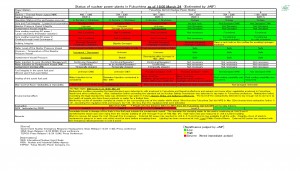
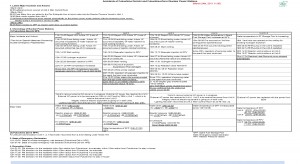
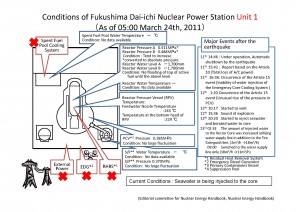
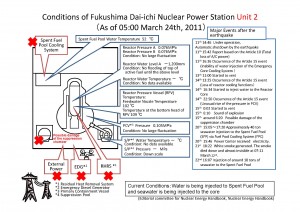
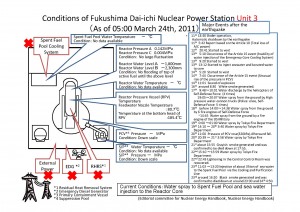
Warning: Declaration of Social_Walker_Comment::start_lvl(&$output, $depth, $args) should be compatible with Walker_Comment::start_lvl(&$output, $depth = 0, $args = Array) in /var/www/nuclearpoweryesplease.org/public_html/blog/wp-content/plugins/social/lib/social/walker/comment.php on line 18
Warning: Declaration of Social_Walker_Comment::end_lvl(&$output, $depth, $args) should be compatible with Walker_Comment::end_lvl(&$output, $depth = 0, $args = Array) in /var/www/nuclearpoweryesplease.org/public_html/blog/wp-content/plugins/social/lib/social/walker/comment.php on line 42
Tre inte två!
“Three workers were exposed to high-level radiation Thursday while laying cable at the troubled Fukushima Daiichi nuclear plant, and two of them were taken to hospital due to possible radiation burns to their feet, the nuclear safety agency and the plant operator said.
The three men in their 20s and 30s were exposed to radiation amounting to 173 to 180 millisieverts at around 12:10 p.m. while laying cable underground at the No. 3 reactor’s turbine building.”
http://english.kyodonews.jp/news/2011/03/80799.html
Congratulations, after 2 weeks of commenting you actually managed to find one slip of the finger I made. I will correct it!
Tja… det är ju faktiskt Kyodo som skrev fel. 🙂 Jämför…
http://english.kyodonews.jp/news/2011/03/80729.html
http://english.kyodonews.jp/news/2011/03/80799.html
Läs om och gör rätt. Det står att tre blev utsatta för kraftig strålning i båda men att två hamnade på sjukhus.
Tack för att du korrigerar oss Per. Vad i allsindar skulle vi ta oss till om inte du var här?
Antagligen sova er törnrosasömn drömmandes om framtidens ofarliga(????) toriumdrivna verk
Övre delen av härden på 123 har varit ovanför vattennivån nu ett bra tag. Låter obra. Förångas inte vatten hela tiden och skapar tryck inne i tanken? Eller månne bränslet faller sönder och rasar ner i vattnet? Finns väl inte så mycket fullskaletester på detta situation av naturliga skäl.
There is a chance that the cooling from below and the steam rising is enough to keep the upper 2 uncovered meters of fuel from melting or the top 2 meters simply do not exist anymore and is lying on the bottom of the vessel now. Its impossible to tell without a proper analysis. For some reason it seems like TEPCO is intentionally keeping the water at that level, or the water level meter is junk(it seems a bit to stable to be realistic).
Water is boiled all the time, but the steam will cool down while rising, condense and flow down again. Passive cooling from natural convection. The boiling rate in number 1 for instance is 4 times higher than the water pumping rate. So a lot of this kind of cooling is going on. At some point natural convection is enough to do the cooling without any external water being pumped in. Not sure how close one is to that point or if it will be reached at all in a realistic time span(the heat production decays very slowly now).
Sorry, forgot to take it in english 🙁
Thanks for compiling the official information in a very god way. Even though I don’t agree with your opinions regarding nuclear power, I still find this blog full of explanations and references to real infomation.
I just wonder, what is normal radiation within the containment? Close to zero or much higher when the plant is in production? A number like 55.6 Sv/h is useless until I know what a “good” value would be.
A good/proper value would be in the order of 0…. there isn’t supposed to be any contamination in the containment. You’re supposed to be able to walk around in there when the reactor is in shutdown.
40-50 Sv/h are extreme levels. We’re talking acute radiation sickness within a minute… lethal doses in 5 minutes.
This means they have three very serious meltdowns happening and we should give great thanks to GE for building the containments well… that has most likely saved the Fukushima prefecture from having to be permanently evacuated.
Then again… that is what they are meant for… saving our asses when things go sour. 🙂